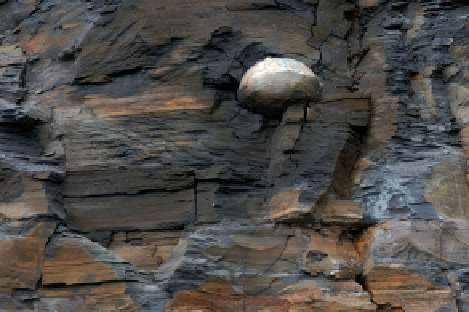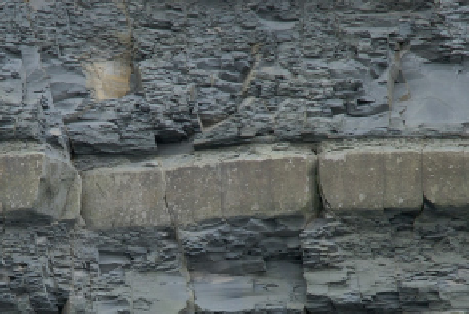Geoscience Reference
In-Depth Information
6
(
(
Figure 6.2
(a) Blocky fracture pattern of a siliciclastic mudrock mainly composed of clay minerals.
(b) Conchoidal fracture pattern of a mudrock with a signifi cant proportion of carbonate. (a and b:
Angela L. Coe, The Open University, UK.)
Conglomerates and breccias
Conglomerates and breccias can be classifi ed according to clast
type and matrix properties (Figure A6.13). In complete contrast
to mudrocks a 'wide angle' view of these coarse-grained
sedimentary deposits is required to obtain representative data
because of the potential large-scale variation. The quadrat
method is useful for assessing and recording coarse-grained
sedimentary deposits (Sections 3.3 and 5.4.2). A quadrat of 0.5
to 1 m square is appropriate for most deposits.
Carbonates
It is useful to look at both a weathered and a fresh surface of
carbonate rocks. The carbonate grains tend to weather out
making them easier to identify on weathered surfaces. There
are two commonly used classifi cation schemes for carbonates
(Appendix A6, Figures A6.11 and A6.12). In both cases it is
necessary to decide fi rst of all whether the grains are bound
together organically (i.e. whether it is a bioherm (reef)) or not).
The Folk classifi cation scheme (Figure A6.11) is easier to use;
it is based on the nature of the grains and whether these are
within matrix or cement. The use of this classifi cation scheme
is illustrated by the following fl owchart:
Folk classification:
dismicrite
Folk classification:
biolithite
yes
yes
Identify the
major grain
types in the
rock (ooids,
peloids,
bioclasts or
intraclasts?)
Put together
the grain (oo-,
pel-, bio-
or intra-) and
either micrite
or sparite
Identify
whether
grains are
in micrite
or sparite
Is it
micrite
with spar
cavities?
Is it
organically
bound?
Folk classification
(e.g. biosparite
or oosparite)
Use Folk
classification
no
no

























